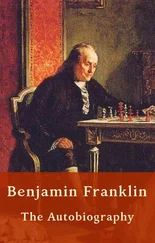Sydney Fisher - The True Benjamin Franklin
Здесь есть возможность читать онлайн «Sydney Fisher - The True Benjamin Franklin» — ознакомительный отрывок электронной книги совершенно бесплатно, а после прочтения отрывка купить полную версию. В некоторых случаях можно слушать аудио, скачать через торрент в формате fb2 и присутствует краткое содержание. Жанр: История, foreign_antique, foreign_prose, Биографии и Мемуары, на английском языке. Описание произведения, (предисловие) а так же отзывы посетителей доступны на портале библиотеки ЛибКат.
- Название:The True Benjamin Franklin
- Автор:
- Жанр:
- Год:неизвестен
- ISBN:нет данных
- Рейтинг книги:4 / 5. Голосов: 1
-
Избранное:Добавить в избранное
- Отзывы:
-
Ваша оценка:
- 80
- 1
- 2
- 3
- 4
- 5
The True Benjamin Franklin: краткое содержание, описание и аннотация
Предлагаем к чтению аннотацию, описание, краткое содержание или предисловие (зависит от того, что написал сам автор книги «The True Benjamin Franklin»). Если вы не нашли необходимую информацию о книге — напишите в комментариях, мы постараемся отыскать её.
The True Benjamin Franklin — читать онлайн ознакомительный отрывок
Ниже представлен текст книги, разбитый по страницам. Система сохранения места последней прочитанной страницы, позволяет с удобством читать онлайн бесплатно книгу «The True Benjamin Franklin», без необходимости каждый раз заново искать на чём Вы остановились. Поставьте закладку, и сможете в любой момент перейти на страницу, на которой закончили чтение.
Интервал:
Закладка:
Much of this is true in a general way, for medical practitioners have long held that all colds do not arise from exposure or draughts; but they do not admit that colds can be taken from turning over old books and clothes, although the dust from these might make one sneeze.
John Adams and Franklin while travelling together through New Jersey to meet Lord Howe, in 1776, discussed the question of colds, and the former has left an amusing account of it. The taverns were so full at Brunswick that they had to sleep in the same bed. Franklin insisted on leaving the window wide open, and discoursed on the causes of colds until they both fell asleep.
“I have often asked him whether a person heated with exercise going suddenly into cold air, or standing still in a current of it, might not have his pores suddenly contracted, his perspiration stopped, and that matter thrown into the circulation, or cast upon the lungs, which he acknowledged was the cause of colds. To this he never could give me a satisfactory answer, and I have heard that in the opinion of his own able physician, Dr. Jones, he fell a sacrifice at last, not to the stone, but to his own theory, having caught the violent cold which finally choked him, by sitting for some hours at a window, with the cool air blowing upon him.” (Adams’s Works, vol. iii. p. 75.)
In some of his letters Franklin denied positively that colds could be taken by exposure. He got a young physician to experiment on the effect of nakedness in increasing perspiration, and when he found, or thought he had found, that the perspiration was greater than when the body was clothed, he jumped to the conclusion that exposure could not check perspiration. In a passage in his notes, however, he seems to admit that a sudden cold air or a draught might check it.
He wrote so well and so prettily on colds that people began to think he was the discoverer of their causes, and his biographer, Parton, goes so far as to say so. But upon inquiry among learned physicians I cannot find that they recognize him as a discoverer, or that he has any standing on this question in medical history. It would seem that he merely collected and expressed the observations of others as well as his own; none of them were entirely new, and many of them are now considered unsound.
Nearer to the truth is Parton’s statement that “he was the first effective preacher of the blessed gospel of ventilation.” He certainly studied that subject very carefully, and was an authority on it, being appointed while in England to prepare a plan for ventilating the Houses of Parliament. It would, however, be better to say that he was one of the most prominent advocates of ventilation rather than the first effective preacher of it; for in Bigelow’s edition of his works 1 1 Vol. iv. p. 271.
will be found an excellent essay on the subject in which the other advocates are mentioned. But Parton goes on to say, “He spoke, and the windows of hospitals were lowered; consumption ceased to gasp and fever to inhale poison;” which is an extravagant statement that he would find difficulty, I think, in supporting.
In Franklin’s published works there is a short essay called “A Conjecture as to the Cause of the Heat of the Blood in Health and of the Cold and Hot Fits of Some Fevers.” The blood is heated, he says, by friction in the action of the heart, by the distention and contraction of the arteries, and by being forced through minute vessels. This essay is very ingenious and well written, and the position given to it in his works might lead one to suppose that it was of importance; but I am informed by physicians that it was merely the revamping of an ancient theory held long before his time, and quite without foundation.
Franklin’s excursions into the domain of medicine are not, therefore, to be considered among his valuable contributions to the welfare of man, except so far as they encouraged him to advocate fresh air and ventilation, though they may have assisted him to take better care of his own health.
Of the numerous portraits of him of varying merit, nearly all of which have been reproduced over and over again, only a few deserve consideration for the light they throw on his appearance and character. The Sumner portrait, as it used to be called, is supposed to have been painted in London in 1726, when he was there as a young journeyman printer, twenty years old, and was brought by him to America and given to his brother John, of Rhode Island. He evidently dressed himself for this picture in clothes he was not in the habit of wearing at his work; for he appears in a large wig, a long, decorated coat and waistcoat, with a mass of white ruffles on his bosom and conspicuous wrist-bands. The rotund and strongly developed figure is well displayed. Great firmness and determination are shown in the mouth and lower part of the face. The animal forces are evidently strong. The face is somewhat frank, and at the same time very shrewd. The eyes are larger than in the later portraits, which is not surprising, for eyes are apt to grow smaller in appearance with age.
This portrait, which is now in Memorial Hall at Harvard University, has been supposed by some critics not to be a portrait of Franklin at all. How, they ask, could Franklin, who was barely able to earn his living at that time, and whose companions were borrowing a large part of his spare money, afford to have an oil-painting made of himself in such expensive costume? and why is there no mention of this portrait in any of his writings? But, on the other hand, the portrait has the peculiar set expression of the mouth and the long chin which were so characteristic of Franklin; and it would have been entirely possible for him to have borrowed the clothes and had the picture painted cheaply or as a kindness. It is not well painted, need not have been expensive, and, as there were no photographs then, paintings were the only way by which people could give their likenesses to relatives.
The Martin portrait, painted when he was about sixty years old, represents him seated, his elbows resting on a table, and holding a document, which he is reading with deep but composed and serene attention. It was no doubt intended to represent him in a characteristic attitude. As showing the calm philosopher and diplomat reading and thinking, somewhat idealized and yet a more or less true likeness, it is in many respects the best picture we have of him. But we cannot see the eyes, and it does not reveal as much character as we could wish.
The Grundmann portrait, an excellent photograph of which hangs in the Philadelphia Library, was painted by a German artist, after a careful study of Franklin’s career and of all the portraits of him which had been painted from life. As an attempt to reproduce his characteristics and idealize them it is a distinct success and very interesting. He is seated in a chair, in his court-dress, with long stockings and knee-breeches, leaning back, his head and shoulders bent forward, while his gaze is downward. He is musing over something, and there is that characteristic shrewd smile on the lower part of the rugged face. It is the smile of a most masterful and cunning intellect; but no one fears it: it seems as harmless as your mother’s. You try to imagine which one of his thousand clever strokes and sayings was passing through his mind that day; and the strong, intensely individualized figure, which resembles that of an old athlete, is wonderfully suggestive of life, experience, and contest.
But the Duplessis portrait, which was painted from life in Paris in 1778, when he was seventy-two, reveals more than any of them. The Sumner portrait is Franklin the youth; the Martin and the Grundmann portraits are Franklin the philosopher and statesman; the Duplessis portrait is Franklin the man.
Unfortunately, it is impossible to get a good reproduction of the Duplessis portrait, because there is so much detail in it and the coloring and lights and shadows cannot be successfully copied. But any one who will examine the original or any good replicas of it in oil will, I am convinced, see Franklin as he really was. The care in details, the wrinkles, and the color of the skin give us confidence in it as a likeness. The round, strong, but crude form of the boy of twenty has been beaten and changed by time into a hundred qualities and accomplishments, yet the original form is still discernible, and the face looks straight at us: we see the eyes and every line close at hand.
Читать дальшеИнтервал:
Закладка:
Похожие книги на «The True Benjamin Franklin»
Представляем Вашему вниманию похожие книги на «The True Benjamin Franklin» списком для выбора. Мы отобрали схожую по названию и смыслу литературу в надежде предоставить читателям больше вариантов отыскать новые, интересные, ещё непрочитанные произведения.
Обсуждение, отзывы о книге «The True Benjamin Franklin» и просто собственные мнения читателей. Оставьте ваши комментарии, напишите, что Вы думаете о произведении, его смысле или главных героях. Укажите что конкретно понравилось, а что нет, и почему Вы так считаете.









![Benjamin Franklin - Memoirs of Benjamin Franklin; Written by Himself. [Vol. 2 of 2]](/books/747975/benjamin-franklin-memoirs-of-benjamin-franklin-wr-thumb.webp)
![Benjamin Franklin - Memoirs of Benjamin Franklin; Written by Himself. [Vol. 1 of 2]](/books/748053/benjamin-franklin-memoirs-of-benjamin-franklin-wr-thumb.webp)

